Organizational Behavior Analysis: Enterprise Car Rental & City College
VerifiedAdded on 2020/01/16
|13
|3890
|372
Report
AI Summary
This report provides an in-depth analysis of organizational behavior, comparing the structures, cultures, and leadership styles of Enterprise Car Rental and City College. It examines the impact of organizational structure (flat vs. tall) and culture (Handy's and Schein's models) on employee performance. The report contrasts autocratic and democratic leadership styles, linking them to classical organizational theories like scientific management and bureaucratic theory. It also explores motivational theories such as Herzberg's two-factor theory and the application of contingency and human relations approaches. The analysis considers factors influencing employee behavior, including attitude, personality, perception, and values, highlighting their effects on motivation, communication, and overall organizational success. The report emphasizes the importance of adapting management strategies to specific organizational contexts to enhance productivity and foster a positive work environment.
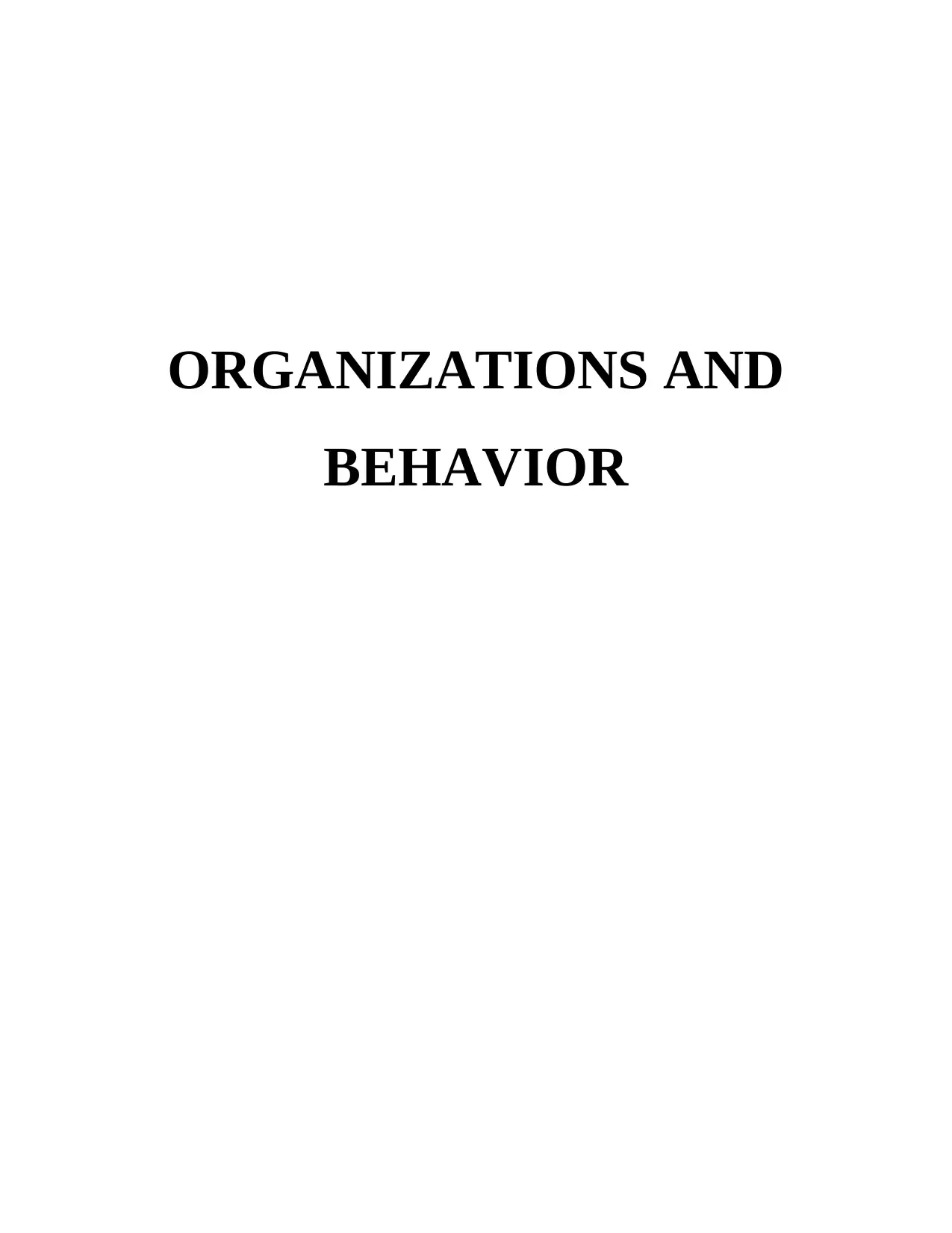
ORGANIZATIONS AND
BEHAVIOR
BEHAVIOR
Paraphrase This Document
Need a fresh take? Get an instant paraphrase of this document with our AI Paraphraser

TABLE OF CONTENTS
INTRODUCTION.........................................................................................................................................3
TASK 1..........................................................................................................................................................3
1.1...............................................................................................................................................................3
1.2...............................................................................................................................................................5
1.3...............................................................................................................................................................6
TASK 2..........................................................................................................................................................6
2.1...............................................................................................................................................................6
2.2...............................................................................................................................................................7
2.3...............................................................................................................................................................7
3.1...............................................................................................................................................................8
3.2...............................................................................................................................................................9
3.3...............................................................................................................................................................9
4.1.............................................................................................................................................................10
4.2.............................................................................................................................................................10
4.3.............................................................................................................................................................11
CONCLUSION............................................................................................................................................11
REFFERENCE............................................................................................................................................12
INTRODUCTION.........................................................................................................................................3
TASK 1..........................................................................................................................................................3
1.1...............................................................................................................................................................3
1.2...............................................................................................................................................................5
1.3...............................................................................................................................................................6
TASK 2..........................................................................................................................................................6
2.1...............................................................................................................................................................6
2.2...............................................................................................................................................................7
2.3...............................................................................................................................................................7
3.1...............................................................................................................................................................8
3.2...............................................................................................................................................................9
3.3...............................................................................................................................................................9
4.1.............................................................................................................................................................10
4.2.............................................................................................................................................................10
4.3.............................................................................................................................................................11
CONCLUSION............................................................................................................................................11
REFFERENCE............................................................................................................................................12
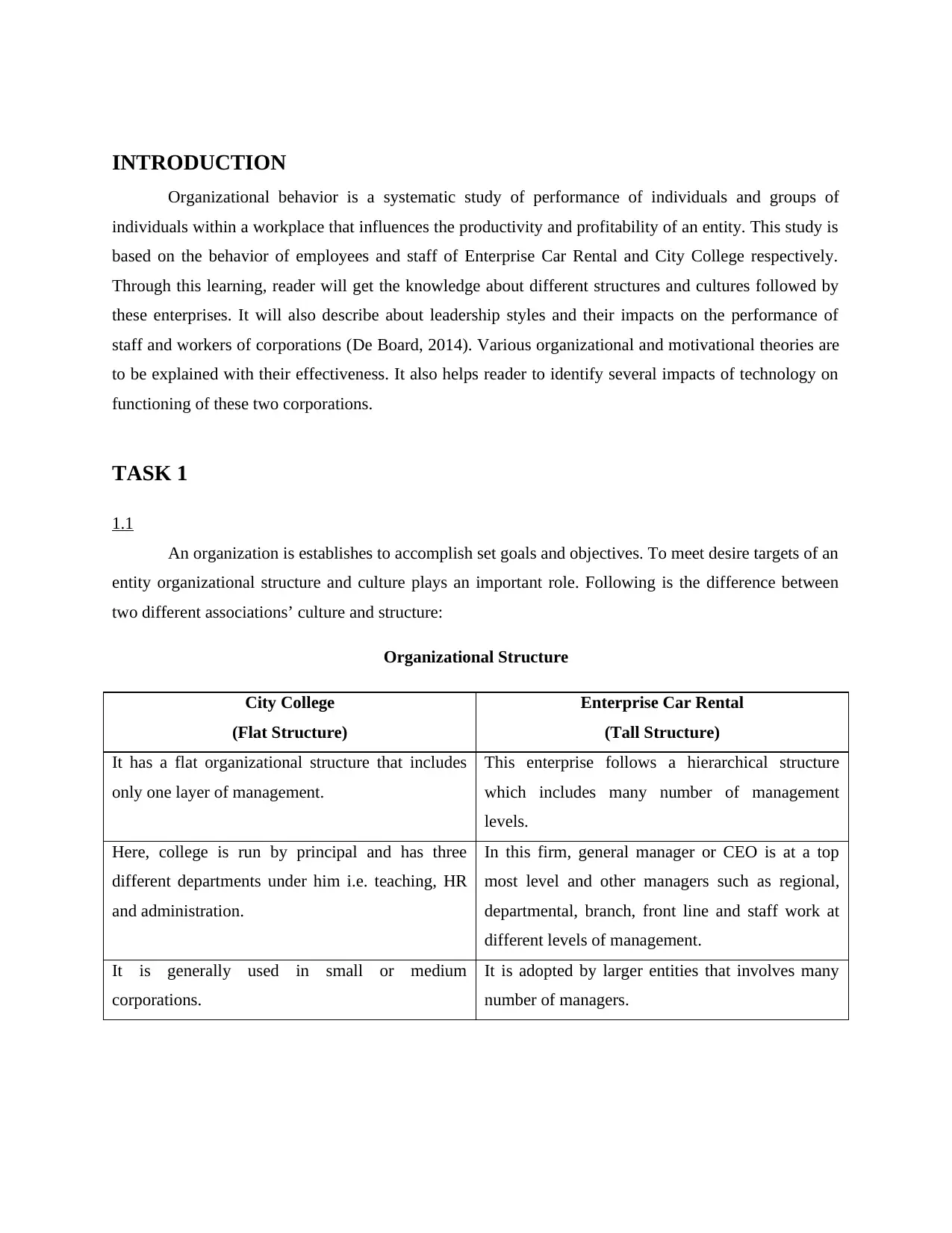
INTRODUCTION
Organizational behavior is a systematic study of performance of individuals and groups of
individuals within a workplace that influences the productivity and profitability of an entity. This study is
based on the behavior of employees and staff of Enterprise Car Rental and City College respectively.
Through this learning, reader will get the knowledge about different structures and cultures followed by
these enterprises. It will also describe about leadership styles and their impacts on the performance of
staff and workers of corporations (De Board, 2014). Various organizational and motivational theories are
to be explained with their effectiveness. It also helps reader to identify several impacts of technology on
functioning of these two corporations.
TASK 1
1.1
An organization is establishes to accomplish set goals and objectives. To meet desire targets of an
entity organizational structure and culture plays an important role. Following is the difference between
two different associations’ culture and structure:
Organizational Structure
City College
(Flat Structure)
Enterprise Car Rental
(Tall Structure)
It has a flat organizational structure that includes
only one layer of management.
This enterprise follows a hierarchical structure
which includes many number of management
levels.
Here, college is run by principal and has three
different departments under him i.e. teaching, HR
and administration.
In this firm, general manager or CEO is at a top
most level and other managers such as regional,
departmental, branch, front line and staff work at
different levels of management.
It is generally used in small or medium
corporations.
It is adopted by larger entities that involves many
number of managers.
Organizational behavior is a systematic study of performance of individuals and groups of
individuals within a workplace that influences the productivity and profitability of an entity. This study is
based on the behavior of employees and staff of Enterprise Car Rental and City College respectively.
Through this learning, reader will get the knowledge about different structures and cultures followed by
these enterprises. It will also describe about leadership styles and their impacts on the performance of
staff and workers of corporations (De Board, 2014). Various organizational and motivational theories are
to be explained with their effectiveness. It also helps reader to identify several impacts of technology on
functioning of these two corporations.
TASK 1
1.1
An organization is establishes to accomplish set goals and objectives. To meet desire targets of an
entity organizational structure and culture plays an important role. Following is the difference between
two different associations’ culture and structure:
Organizational Structure
City College
(Flat Structure)
Enterprise Car Rental
(Tall Structure)
It has a flat organizational structure that includes
only one layer of management.
This enterprise follows a hierarchical structure
which includes many number of management
levels.
Here, college is run by principal and has three
different departments under him i.e. teaching, HR
and administration.
In this firm, general manager or CEO is at a top
most level and other managers such as regional,
departmental, branch, front line and staff work at
different levels of management.
It is generally used in small or medium
corporations.
It is adopted by larger entities that involves many
number of managers.
⊘ This is a preview!⊘
Do you want full access?
Subscribe today to unlock all pages.

Trusted by 1+ million students worldwide
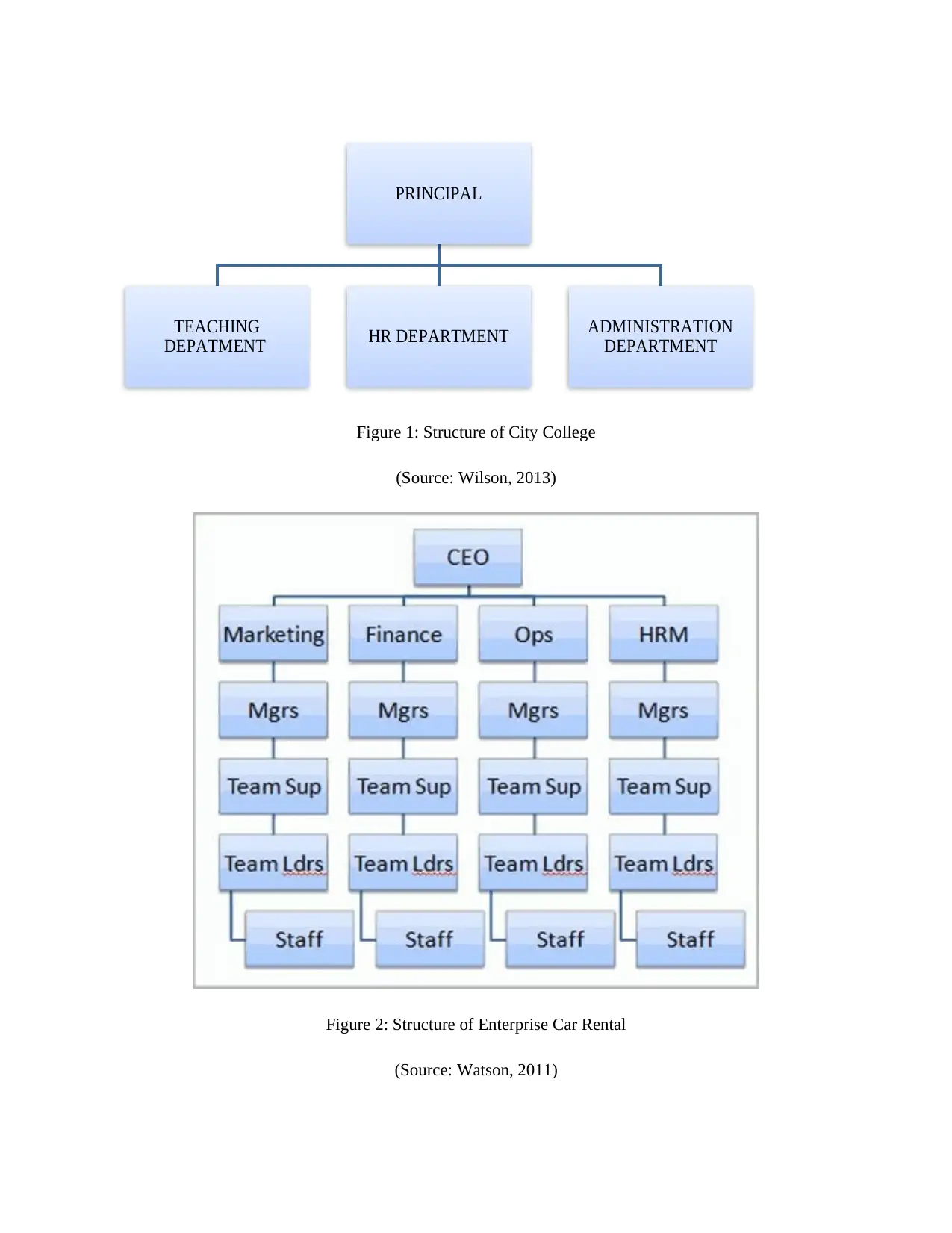
Figure 1: Structure of City College
(Source: Wilson, 2013)
Figure 2: Structure of Enterprise Car Rental
(Source: Watson, 2011)
PRINCIPAL
TEACHING
DEPATMENT HR DEPARTMENT ADMINISTRATION
DEPARTMENT
(Source: Wilson, 2013)
Figure 2: Structure of Enterprise Car Rental
(Source: Watson, 2011)
PRINCIPAL
TEACHING
DEPATMENT HR DEPARTMENT ADMINISTRATION
DEPARTMENT
Paraphrase This Document
Need a fresh take? Get an instant paraphrase of this document with our AI Paraphraser

Organizational Culture
City College
(Charles Handy’s Model)
Enterprise Car Rental
(Edgar Schein’s Model)
Handy’s model of organizational culture includes
four types of cultures i.e. power, role, person and
task and it follows power culture where person at
top has authority to take all decisions (Clegg and
Dunkerley, 2013).
This model includes three elements which are inter-
related to each other i.e. artifacts, espoused values
and basic underlying assumptions.
Here, principal delegates tasks and work to the rest
of the staff and helpful in quick decision making
process.
Here, not such delegation of authority or task is
required.
In this, employees do not make any importance. Under this, dress code of employees, office
furniture, facilities, their values, behavior, attitudes,
beliefs, etc. are more important.
1.2
A structure and culture of any organization is inter-related to each other. Their impacts on the
performance of both of the above entities are discussed below:
Impact of organizational structure and culture on City College
As this college has a flat organizational structure, so power culture is suits for this entity. In
power culture, all powers or authority exist in the hands of principal and he only delegates duties and
targets to his staff. It has both positive and negative impact on the performance of its staff members. Here,
all decisions are taken by the principal of the college and staff members have to follow his instructions.
The performance of members are observed and controlled by him. Therefore, they perform as per his
directions.
Impact of organizational structure and culture on Enterprise Car Rental
This enterprise adopted tall structure to run its business due to a number of people involved in it.
Here, management focuses more on development of their employees (Hogg and Terry, 2014). They
treated as the asset of the company. Through this, workforce is encouraged and motivated towards their
work that, results in better productivity and profitability. This structure and culture facilitate a favorable
working environment and that is essential for the success of any business.
City College
(Charles Handy’s Model)
Enterprise Car Rental
(Edgar Schein’s Model)
Handy’s model of organizational culture includes
four types of cultures i.e. power, role, person and
task and it follows power culture where person at
top has authority to take all decisions (Clegg and
Dunkerley, 2013).
This model includes three elements which are inter-
related to each other i.e. artifacts, espoused values
and basic underlying assumptions.
Here, principal delegates tasks and work to the rest
of the staff and helpful in quick decision making
process.
Here, not such delegation of authority or task is
required.
In this, employees do not make any importance. Under this, dress code of employees, office
furniture, facilities, their values, behavior, attitudes,
beliefs, etc. are more important.
1.2
A structure and culture of any organization is inter-related to each other. Their impacts on the
performance of both of the above entities are discussed below:
Impact of organizational structure and culture on City College
As this college has a flat organizational structure, so power culture is suits for this entity. In
power culture, all powers or authority exist in the hands of principal and he only delegates duties and
targets to his staff. It has both positive and negative impact on the performance of its staff members. Here,
all decisions are taken by the principal of the college and staff members have to follow his instructions.
The performance of members are observed and controlled by him. Therefore, they perform as per his
directions.
Impact of organizational structure and culture on Enterprise Car Rental
This enterprise adopted tall structure to run its business due to a number of people involved in it.
Here, management focuses more on development of their employees (Hogg and Terry, 2014). They
treated as the asset of the company. Through this, workforce is encouraged and motivated towards their
work that, results in better productivity and profitability. This structure and culture facilitate a favorable
working environment and that is essential for the success of any business.
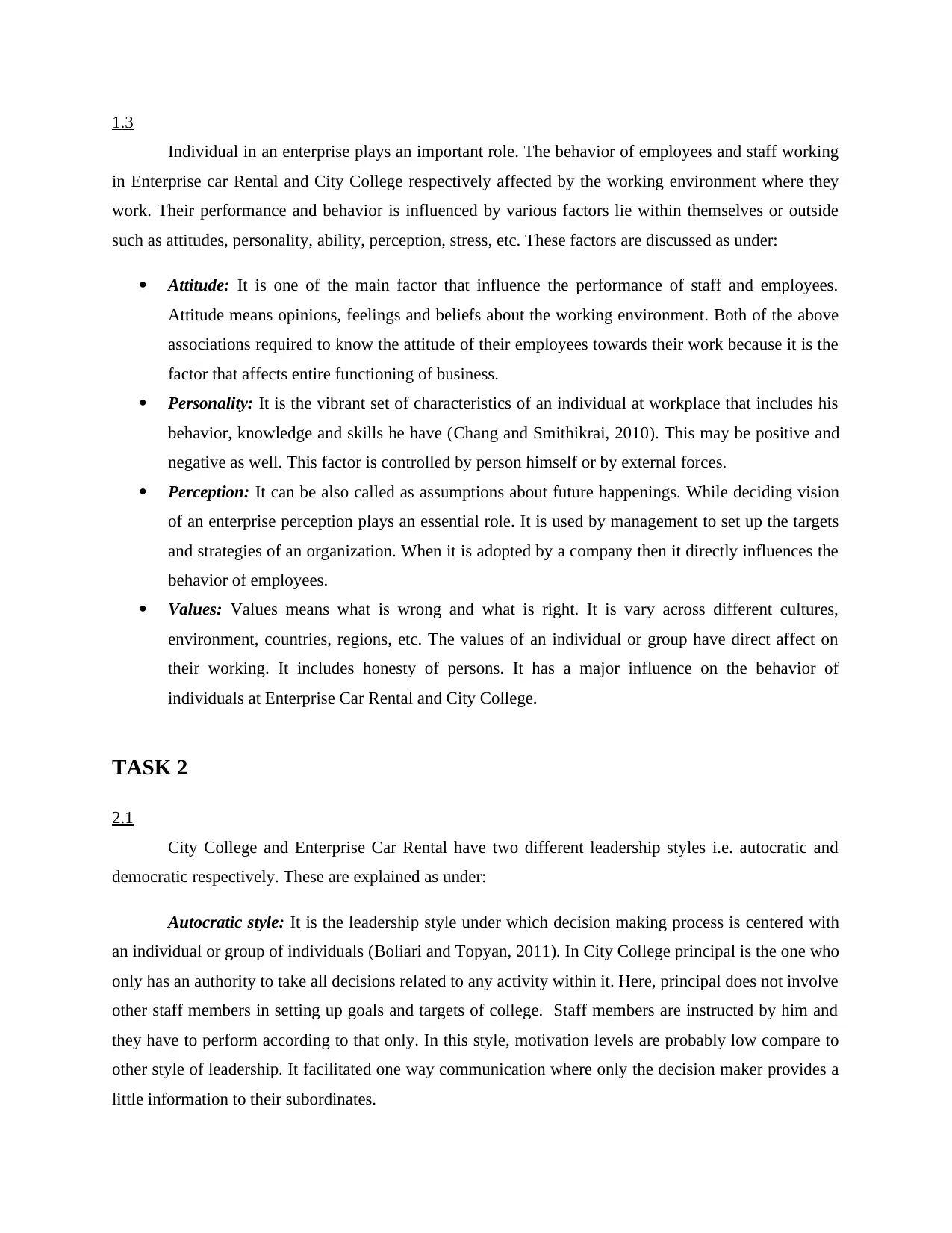
1.3
Individual in an enterprise plays an important role. The behavior of employees and staff working
in Enterprise car Rental and City College respectively affected by the working environment where they
work. Their performance and behavior is influenced by various factors lie within themselves or outside
such as attitudes, personality, ability, perception, stress, etc. These factors are discussed as under:
Attitude: It is one of the main factor that influence the performance of staff and employees.
Attitude means opinions, feelings and beliefs about the working environment. Both of the above
associations required to know the attitude of their employees towards their work because it is the
factor that affects entire functioning of business.
Personality: It is the vibrant set of characteristics of an individual at workplace that includes his
behavior, knowledge and skills he have (Chang and Smithikrai, 2010). This may be positive and
negative as well. This factor is controlled by person himself or by external forces.
Perception: It can be also called as assumptions about future happenings. While deciding vision
of an enterprise perception plays an essential role. It is used by management to set up the targets
and strategies of an organization. When it is adopted by a company then it directly influences the
behavior of employees.
Values: Values means what is wrong and what is right. It is vary across different cultures,
environment, countries, regions, etc. The values of an individual or group have direct affect on
their working. It includes honesty of persons. It has a major influence on the behavior of
individuals at Enterprise Car Rental and City College.
TASK 2
2.1
City College and Enterprise Car Rental have two different leadership styles i.e. autocratic and
democratic respectively. These are explained as under:
Autocratic style: It is the leadership style under which decision making process is centered with
an individual or group of individuals (Boliari and Topyan, 2011). In City College principal is the one who
only has an authority to take all decisions related to any activity within it. Here, principal does not involve
other staff members in setting up goals and targets of college. Staff members are instructed by him and
they have to perform according to that only. In this style, motivation levels are probably low compare to
other style of leadership. It facilitated one way communication where only the decision maker provides a
little information to their subordinates.
Individual in an enterprise plays an important role. The behavior of employees and staff working
in Enterprise car Rental and City College respectively affected by the working environment where they
work. Their performance and behavior is influenced by various factors lie within themselves or outside
such as attitudes, personality, ability, perception, stress, etc. These factors are discussed as under:
Attitude: It is one of the main factor that influence the performance of staff and employees.
Attitude means opinions, feelings and beliefs about the working environment. Both of the above
associations required to know the attitude of their employees towards their work because it is the
factor that affects entire functioning of business.
Personality: It is the vibrant set of characteristics of an individual at workplace that includes his
behavior, knowledge and skills he have (Chang and Smithikrai, 2010). This may be positive and
negative as well. This factor is controlled by person himself or by external forces.
Perception: It can be also called as assumptions about future happenings. While deciding vision
of an enterprise perception plays an essential role. It is used by management to set up the targets
and strategies of an organization. When it is adopted by a company then it directly influences the
behavior of employees.
Values: Values means what is wrong and what is right. It is vary across different cultures,
environment, countries, regions, etc. The values of an individual or group have direct affect on
their working. It includes honesty of persons. It has a major influence on the behavior of
individuals at Enterprise Car Rental and City College.
TASK 2
2.1
City College and Enterprise Car Rental have two different leadership styles i.e. autocratic and
democratic respectively. These are explained as under:
Autocratic style: It is the leadership style under which decision making process is centered with
an individual or group of individuals (Boliari and Topyan, 2011). In City College principal is the one who
only has an authority to take all decisions related to any activity within it. Here, principal does not involve
other staff members in setting up goals and targets of college. Staff members are instructed by him and
they have to perform according to that only. In this style, motivation levels are probably low compare to
other style of leadership. It facilitated one way communication where only the decision maker provides a
little information to their subordinates.
⊘ This is a preview!⊘
Do you want full access?
Subscribe today to unlock all pages.

Trusted by 1+ million students worldwide
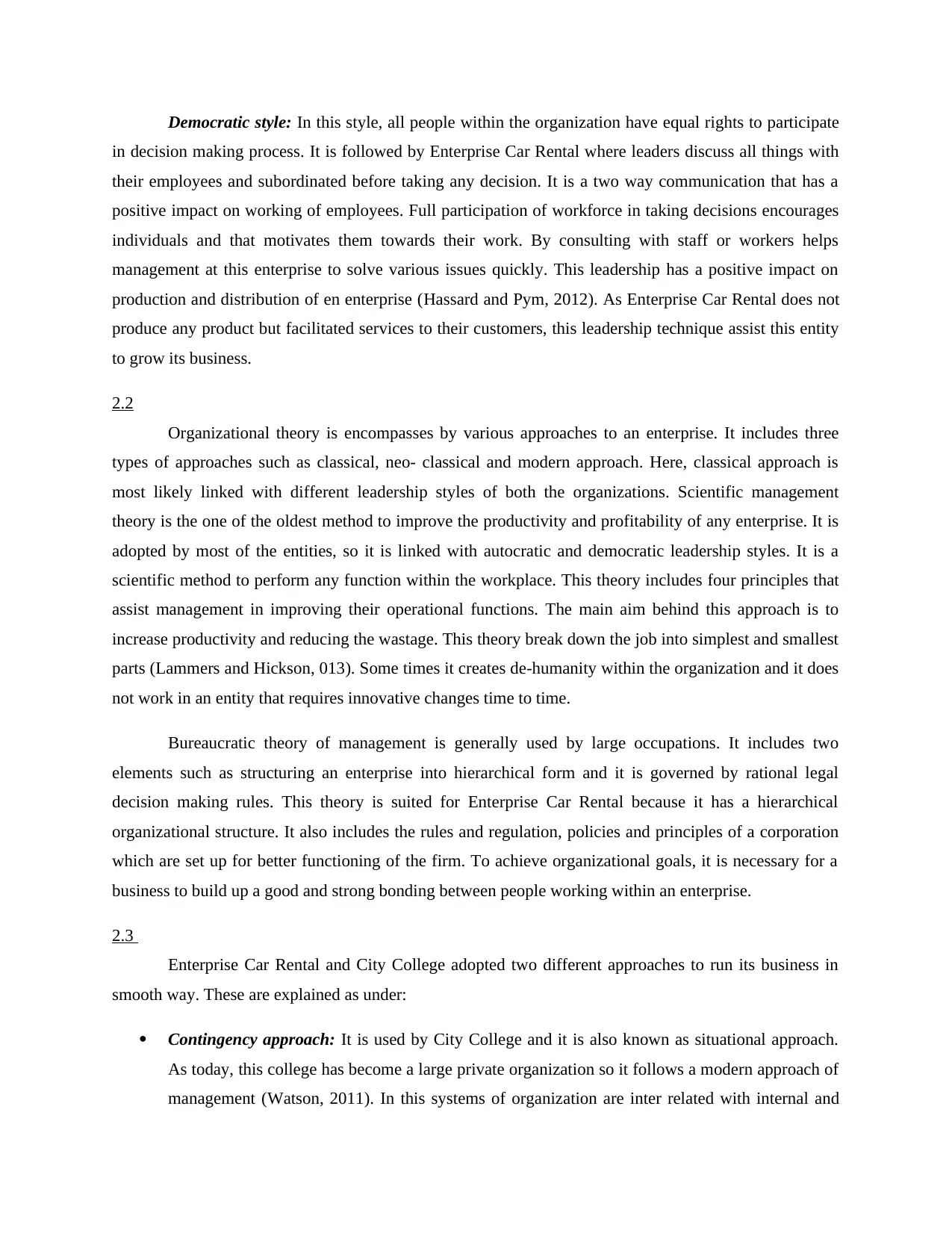
Democratic style: In this style, all people within the organization have equal rights to participate
in decision making process. It is followed by Enterprise Car Rental where leaders discuss all things with
their employees and subordinated before taking any decision. It is a two way communication that has a
positive impact on working of employees. Full participation of workforce in taking decisions encourages
individuals and that motivates them towards their work. By consulting with staff or workers helps
management at this enterprise to solve various issues quickly. This leadership has a positive impact on
production and distribution of en enterprise (Hassard and Pym, 2012). As Enterprise Car Rental does not
produce any product but facilitated services to their customers, this leadership technique assist this entity
to grow its business.
2.2
Organizational theory is encompasses by various approaches to an enterprise. It includes three
types of approaches such as classical, neo- classical and modern approach. Here, classical approach is
most likely linked with different leadership styles of both the organizations. Scientific management
theory is the one of the oldest method to improve the productivity and profitability of any enterprise. It is
adopted by most of the entities, so it is linked with autocratic and democratic leadership styles. It is a
scientific method to perform any function within the workplace. This theory includes four principles that
assist management in improving their operational functions. The main aim behind this approach is to
increase productivity and reducing the wastage. This theory break down the job into simplest and smallest
parts (Lammers and Hickson, 013). Some times it creates de-humanity within the organization and it does
not work in an entity that requires innovative changes time to time.
Bureaucratic theory of management is generally used by large occupations. It includes two
elements such as structuring an enterprise into hierarchical form and it is governed by rational legal
decision making rules. This theory is suited for Enterprise Car Rental because it has a hierarchical
organizational structure. It also includes the rules and regulation, policies and principles of a corporation
which are set up for better functioning of the firm. To achieve organizational goals, it is necessary for a
business to build up a good and strong bonding between people working within an enterprise.
2.3
Enterprise Car Rental and City College adopted two different approaches to run its business in
smooth way. These are explained as under:
Contingency approach: It is used by City College and it is also known as situational approach.
As today, this college has become a large private organization so it follows a modern approach of
management (Watson, 2011). In this systems of organization are inter related with internal and
in decision making process. It is followed by Enterprise Car Rental where leaders discuss all things with
their employees and subordinated before taking any decision. It is a two way communication that has a
positive impact on working of employees. Full participation of workforce in taking decisions encourages
individuals and that motivates them towards their work. By consulting with staff or workers helps
management at this enterprise to solve various issues quickly. This leadership has a positive impact on
production and distribution of en enterprise (Hassard and Pym, 2012). As Enterprise Car Rental does not
produce any product but facilitated services to their customers, this leadership technique assist this entity
to grow its business.
2.2
Organizational theory is encompasses by various approaches to an enterprise. It includes three
types of approaches such as classical, neo- classical and modern approach. Here, classical approach is
most likely linked with different leadership styles of both the organizations. Scientific management
theory is the one of the oldest method to improve the productivity and profitability of any enterprise. It is
adopted by most of the entities, so it is linked with autocratic and democratic leadership styles. It is a
scientific method to perform any function within the workplace. This theory includes four principles that
assist management in improving their operational functions. The main aim behind this approach is to
increase productivity and reducing the wastage. This theory break down the job into simplest and smallest
parts (Lammers and Hickson, 013). Some times it creates de-humanity within the organization and it does
not work in an entity that requires innovative changes time to time.
Bureaucratic theory of management is generally used by large occupations. It includes two
elements such as structuring an enterprise into hierarchical form and it is governed by rational legal
decision making rules. This theory is suited for Enterprise Car Rental because it has a hierarchical
organizational structure. It also includes the rules and regulation, policies and principles of a corporation
which are set up for better functioning of the firm. To achieve organizational goals, it is necessary for a
business to build up a good and strong bonding between people working within an enterprise.
2.3
Enterprise Car Rental and City College adopted two different approaches to run its business in
smooth way. These are explained as under:
Contingency approach: It is used by City College and it is also known as situational approach.
As today, this college has become a large private organization so it follows a modern approach of
management (Watson, 2011). In this systems of organization are inter related with internal and
Paraphrase This Document
Need a fresh take? Get an instant paraphrase of this document with our AI Paraphraser
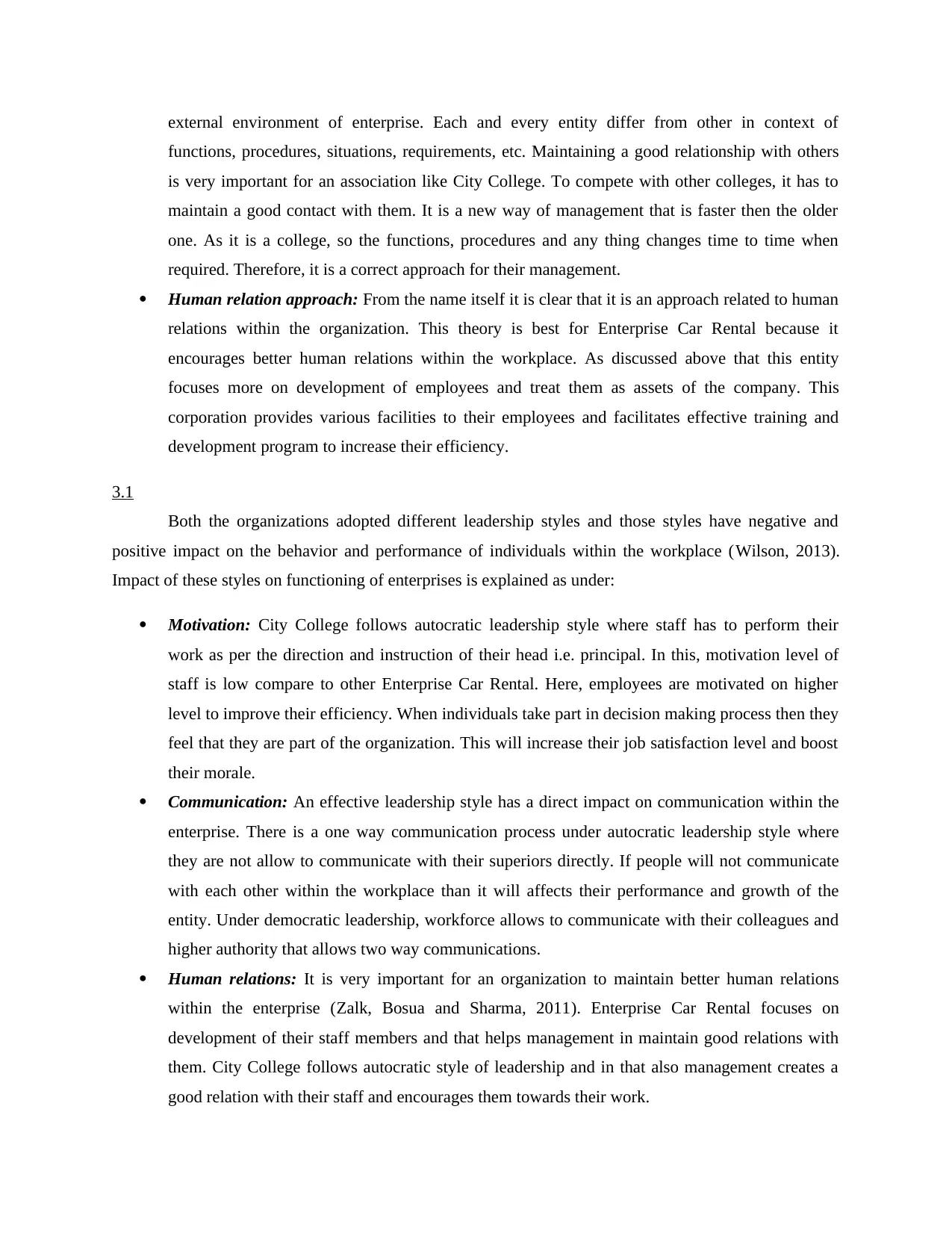
external environment of enterprise. Each and every entity differ from other in context of
functions, procedures, situations, requirements, etc. Maintaining a good relationship with others
is very important for an association like City College. To compete with other colleges, it has to
maintain a good contact with them. It is a new way of management that is faster then the older
one. As it is a college, so the functions, procedures and any thing changes time to time when
required. Therefore, it is a correct approach for their management.
Human relation approach: From the name itself it is clear that it is an approach related to human
relations within the organization. This theory is best for Enterprise Car Rental because it
encourages better human relations within the workplace. As discussed above that this entity
focuses more on development of employees and treat them as assets of the company. This
corporation provides various facilities to their employees and facilitates effective training and
development program to increase their efficiency.
3.1
Both the organizations adopted different leadership styles and those styles have negative and
positive impact on the behavior and performance of individuals within the workplace (Wilson, 2013).
Impact of these styles on functioning of enterprises is explained as under:
Motivation: City College follows autocratic leadership style where staff has to perform their
work as per the direction and instruction of their head i.e. principal. In this, motivation level of
staff is low compare to other Enterprise Car Rental. Here, employees are motivated on higher
level to improve their efficiency. When individuals take part in decision making process then they
feel that they are part of the organization. This will increase their job satisfaction level and boost
their morale.
Communication: An effective leadership style has a direct impact on communication within the
enterprise. There is a one way communication process under autocratic leadership style where
they are not allow to communicate with their superiors directly. If people will not communicate
with each other within the workplace than it will affects their performance and growth of the
entity. Under democratic leadership, workforce allows to communicate with their colleagues and
higher authority that allows two way communications.
Human relations: It is very important for an organization to maintain better human relations
within the enterprise (Zalk, Bosua and Sharma, 2011). Enterprise Car Rental focuses on
development of their staff members and that helps management in maintain good relations with
them. City College follows autocratic style of leadership and in that also management creates a
good relation with their staff and encourages them towards their work.
functions, procedures, situations, requirements, etc. Maintaining a good relationship with others
is very important for an association like City College. To compete with other colleges, it has to
maintain a good contact with them. It is a new way of management that is faster then the older
one. As it is a college, so the functions, procedures and any thing changes time to time when
required. Therefore, it is a correct approach for their management.
Human relation approach: From the name itself it is clear that it is an approach related to human
relations within the organization. This theory is best for Enterprise Car Rental because it
encourages better human relations within the workplace. As discussed above that this entity
focuses more on development of employees and treat them as assets of the company. This
corporation provides various facilities to their employees and facilitates effective training and
development program to increase their efficiency.
3.1
Both the organizations adopted different leadership styles and those styles have negative and
positive impact on the behavior and performance of individuals within the workplace (Wilson, 2013).
Impact of these styles on functioning of enterprises is explained as under:
Motivation: City College follows autocratic leadership style where staff has to perform their
work as per the direction and instruction of their head i.e. principal. In this, motivation level of
staff is low compare to other Enterprise Car Rental. Here, employees are motivated on higher
level to improve their efficiency. When individuals take part in decision making process then they
feel that they are part of the organization. This will increase their job satisfaction level and boost
their morale.
Communication: An effective leadership style has a direct impact on communication within the
enterprise. There is a one way communication process under autocratic leadership style where
they are not allow to communicate with their superiors directly. If people will not communicate
with each other within the workplace than it will affects their performance and growth of the
entity. Under democratic leadership, workforce allows to communicate with their colleagues and
higher authority that allows two way communications.
Human relations: It is very important for an organization to maintain better human relations
within the enterprise (Zalk, Bosua and Sharma, 2011). Enterprise Car Rental focuses on
development of their staff members and that helps management in maintain good relations with
them. City College follows autocratic style of leadership and in that also management creates a
good relation with their staff and encourages them towards their work.
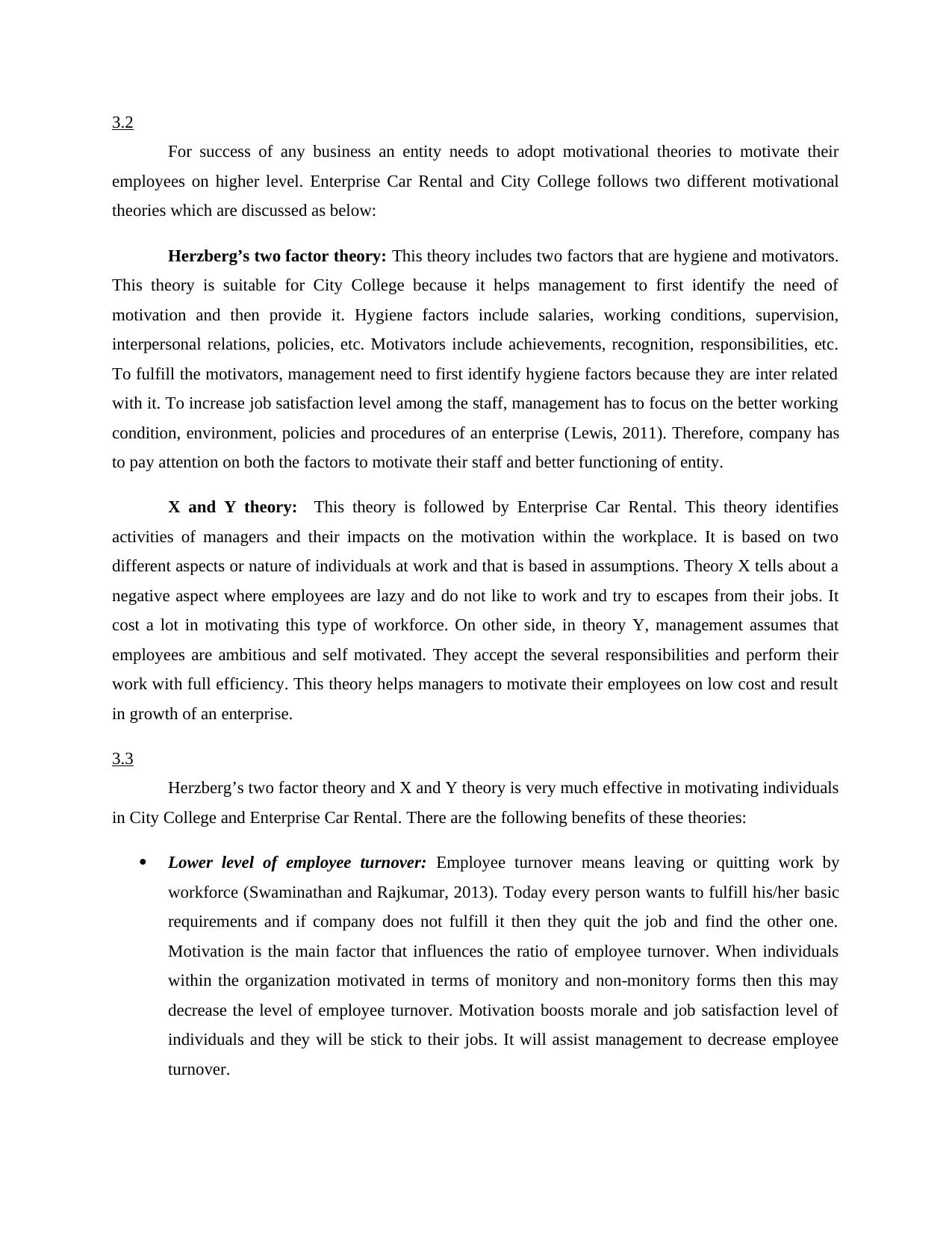
3.2
For success of any business an entity needs to adopt motivational theories to motivate their
employees on higher level. Enterprise Car Rental and City College follows two different motivational
theories which are discussed as below:
Herzberg’s two factor theory: This theory includes two factors that are hygiene and motivators.
This theory is suitable for City College because it helps management to first identify the need of
motivation and then provide it. Hygiene factors include salaries, working conditions, supervision,
interpersonal relations, policies, etc. Motivators include achievements, recognition, responsibilities, etc.
To fulfill the motivators, management need to first identify hygiene factors because they are inter related
with it. To increase job satisfaction level among the staff, management has to focus on the better working
condition, environment, policies and procedures of an enterprise (Lewis, 2011). Therefore, company has
to pay attention on both the factors to motivate their staff and better functioning of entity.
X and Y theory: This theory is followed by Enterprise Car Rental. This theory identifies
activities of managers and their impacts on the motivation within the workplace. It is based on two
different aspects or nature of individuals at work and that is based in assumptions. Theory X tells about a
negative aspect where employees are lazy and do not like to work and try to escapes from their jobs. It
cost a lot in motivating this type of workforce. On other side, in theory Y, management assumes that
employees are ambitious and self motivated. They accept the several responsibilities and perform their
work with full efficiency. This theory helps managers to motivate their employees on low cost and result
in growth of an enterprise.
3.3
Herzberg’s two factor theory and X and Y theory is very much effective in motivating individuals
in City College and Enterprise Car Rental. There are the following benefits of these theories:
Lower level of employee turnover: Employee turnover means leaving or quitting work by
workforce (Swaminathan and Rajkumar, 2013). Today every person wants to fulfill his/her basic
requirements and if company does not fulfill it then they quit the job and find the other one.
Motivation is the main factor that influences the ratio of employee turnover. When individuals
within the organization motivated in terms of monitory and non-monitory forms then this may
decrease the level of employee turnover. Motivation boosts morale and job satisfaction level of
individuals and they will be stick to their jobs. It will assist management to decrease employee
turnover.
For success of any business an entity needs to adopt motivational theories to motivate their
employees on higher level. Enterprise Car Rental and City College follows two different motivational
theories which are discussed as below:
Herzberg’s two factor theory: This theory includes two factors that are hygiene and motivators.
This theory is suitable for City College because it helps management to first identify the need of
motivation and then provide it. Hygiene factors include salaries, working conditions, supervision,
interpersonal relations, policies, etc. Motivators include achievements, recognition, responsibilities, etc.
To fulfill the motivators, management need to first identify hygiene factors because they are inter related
with it. To increase job satisfaction level among the staff, management has to focus on the better working
condition, environment, policies and procedures of an enterprise (Lewis, 2011). Therefore, company has
to pay attention on both the factors to motivate their staff and better functioning of entity.
X and Y theory: This theory is followed by Enterprise Car Rental. This theory identifies
activities of managers and their impacts on the motivation within the workplace. It is based on two
different aspects or nature of individuals at work and that is based in assumptions. Theory X tells about a
negative aspect where employees are lazy and do not like to work and try to escapes from their jobs. It
cost a lot in motivating this type of workforce. On other side, in theory Y, management assumes that
employees are ambitious and self motivated. They accept the several responsibilities and perform their
work with full efficiency. This theory helps managers to motivate their employees on low cost and result
in growth of an enterprise.
3.3
Herzberg’s two factor theory and X and Y theory is very much effective in motivating individuals
in City College and Enterprise Car Rental. There are the following benefits of these theories:
Lower level of employee turnover: Employee turnover means leaving or quitting work by
workforce (Swaminathan and Rajkumar, 2013). Today every person wants to fulfill his/her basic
requirements and if company does not fulfill it then they quit the job and find the other one.
Motivation is the main factor that influences the ratio of employee turnover. When individuals
within the organization motivated in terms of monitory and non-monitory forms then this may
decrease the level of employee turnover. Motivation boosts morale and job satisfaction level of
individuals and they will be stick to their jobs. It will assist management to decrease employee
turnover.
⊘ This is a preview!⊘
Do you want full access?
Subscribe today to unlock all pages.

Trusted by 1+ million students worldwide
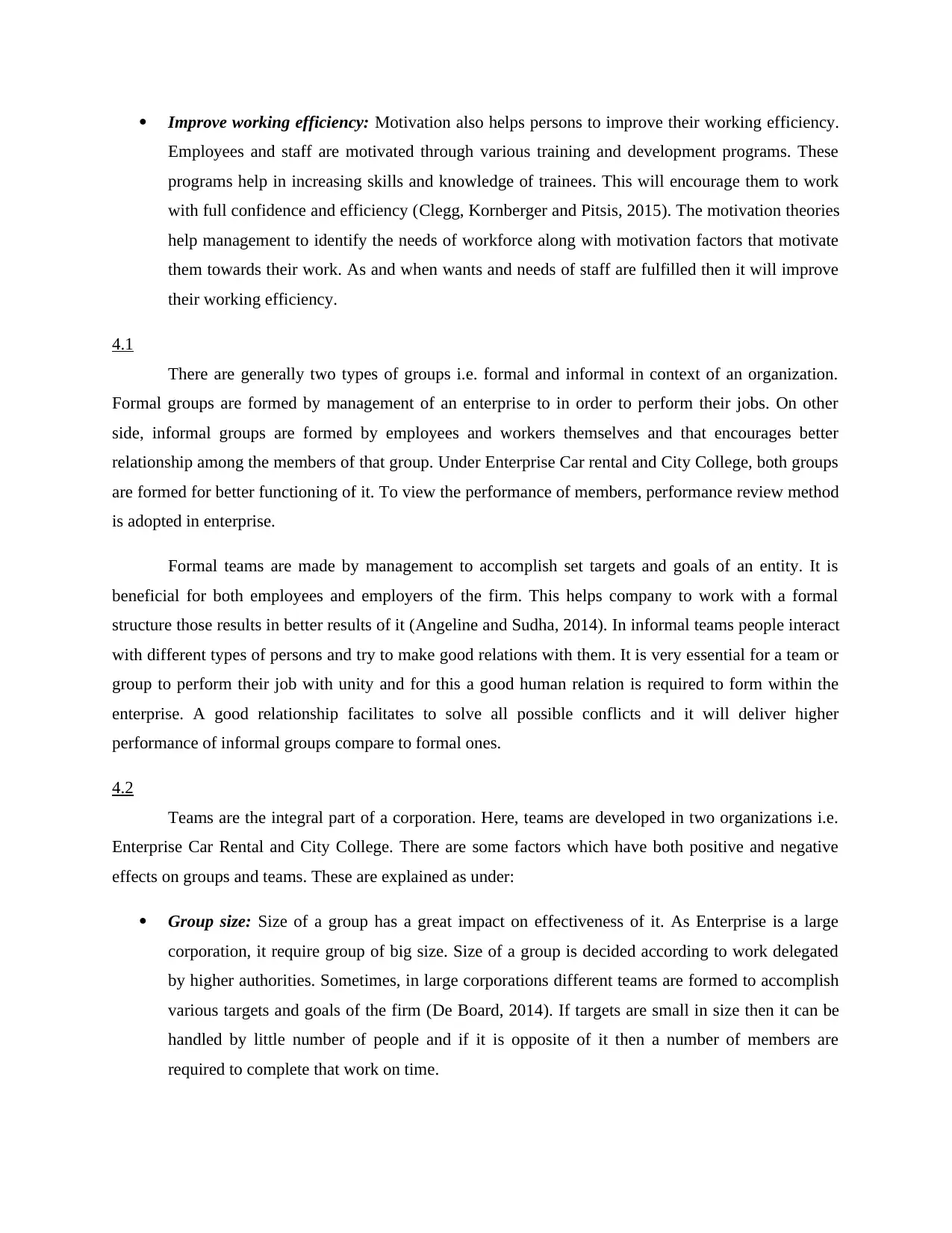
Improve working efficiency: Motivation also helps persons to improve their working efficiency.
Employees and staff are motivated through various training and development programs. These
programs help in increasing skills and knowledge of trainees. This will encourage them to work
with full confidence and efficiency (Clegg, Kornberger and Pitsis, 2015). The motivation theories
help management to identify the needs of workforce along with motivation factors that motivate
them towards their work. As and when wants and needs of staff are fulfilled then it will improve
their working efficiency.
4.1
There are generally two types of groups i.e. formal and informal in context of an organization.
Formal groups are formed by management of an enterprise to in order to perform their jobs. On other
side, informal groups are formed by employees and workers themselves and that encourages better
relationship among the members of that group. Under Enterprise Car rental and City College, both groups
are formed for better functioning of it. To view the performance of members, performance review method
is adopted in enterprise.
Formal teams are made by management to accomplish set targets and goals of an entity. It is
beneficial for both employees and employers of the firm. This helps company to work with a formal
structure those results in better results of it (Angeline and Sudha, 2014). In informal teams people interact
with different types of persons and try to make good relations with them. It is very essential for a team or
group to perform their job with unity and for this a good human relation is required to form within the
enterprise. A good relationship facilitates to solve all possible conflicts and it will deliver higher
performance of informal groups compare to formal ones.
4.2
Teams are the integral part of a corporation. Here, teams are developed in two organizations i.e.
Enterprise Car Rental and City College. There are some factors which have both positive and negative
effects on groups and teams. These are explained as under:
Group size: Size of a group has a great impact on effectiveness of it. As Enterprise is a large
corporation, it require group of big size. Size of a group is decided according to work delegated
by higher authorities. Sometimes, in large corporations different teams are formed to accomplish
various targets and goals of the firm (De Board, 2014). If targets are small in size then it can be
handled by little number of people and if it is opposite of it then a number of members are
required to complete that work on time.
Employees and staff are motivated through various training and development programs. These
programs help in increasing skills and knowledge of trainees. This will encourage them to work
with full confidence and efficiency (Clegg, Kornberger and Pitsis, 2015). The motivation theories
help management to identify the needs of workforce along with motivation factors that motivate
them towards their work. As and when wants and needs of staff are fulfilled then it will improve
their working efficiency.
4.1
There are generally two types of groups i.e. formal and informal in context of an organization.
Formal groups are formed by management of an enterprise to in order to perform their jobs. On other
side, informal groups are formed by employees and workers themselves and that encourages better
relationship among the members of that group. Under Enterprise Car rental and City College, both groups
are formed for better functioning of it. To view the performance of members, performance review method
is adopted in enterprise.
Formal teams are made by management to accomplish set targets and goals of an entity. It is
beneficial for both employees and employers of the firm. This helps company to work with a formal
structure those results in better results of it (Angeline and Sudha, 2014). In informal teams people interact
with different types of persons and try to make good relations with them. It is very essential for a team or
group to perform their job with unity and for this a good human relation is required to form within the
enterprise. A good relationship facilitates to solve all possible conflicts and it will deliver higher
performance of informal groups compare to formal ones.
4.2
Teams are the integral part of a corporation. Here, teams are developed in two organizations i.e.
Enterprise Car Rental and City College. There are some factors which have both positive and negative
effects on groups and teams. These are explained as under:
Group size: Size of a group has a great impact on effectiveness of it. As Enterprise is a large
corporation, it require group of big size. Size of a group is decided according to work delegated
by higher authorities. Sometimes, in large corporations different teams are formed to accomplish
various targets and goals of the firm (De Board, 2014). If targets are small in size then it can be
handled by little number of people and if it is opposite of it then a number of members are
required to complete that work on time.
Paraphrase This Document
Need a fresh take? Get an instant paraphrase of this document with our AI Paraphraser

Group knowledge and skills: Another factor that influences the effectiveness of a team is skills
and knowledge of team members in order to accomplish it. All members of a group should have a
proper knowledge of the work which is allotted to them otherwise they will not able to work
properly (Boliari and Topyan, 2011). It is necessary for a team to have skilled persons who are
specialized in that work. If unskilled and untrained persons form a team then it will difficult for
them to complete that work. Therefore, presence and absence of this factor affects effectiveness
of the team.
4.3
Technology plays a vital role in development of any business. These two corporations Enterprise
Car Rental and City College succeed in implementing new technologies in their operations to meet the
requirements of their customers. This provide following facilities:
Effective communication: Through adoption of latest technology, communication becomes very
easy among the members of every organization. It is very useful in context of both of these
companies (Lewis, 2011). By latest techniques of communication such as emails, fax, etc.
information is transferred from a person to another within few seconds that helps management to
convey information very fast. Through this flow of information become very easy and cost
effective.
Effective performance of staff: Today, adoption of latest technology helps management to
accomplish their set targets within a stimulated time period. In present time, each and every entity
adopted new techniques of working that improves the performance of their staff.
CONCLUSION
This report concluded that organization behavior is very important in managing business
activities. In this report, Enterprise Car Rental and City College follows two different organizational
structures i.e. tall and flat structure respectively. Different motivational theories, leadership styles and
their impacts on performance of working of their staff are explained in this. In order to achieve set targets
both enterprises need to adopt innovative techniques. It also explained about formation of formal and
informal groups to achieve its set objectives and goals.
and knowledge of team members in order to accomplish it. All members of a group should have a
proper knowledge of the work which is allotted to them otherwise they will not able to work
properly (Boliari and Topyan, 2011). It is necessary for a team to have skilled persons who are
specialized in that work. If unskilled and untrained persons form a team then it will difficult for
them to complete that work. Therefore, presence and absence of this factor affects effectiveness
of the team.
4.3
Technology plays a vital role in development of any business. These two corporations Enterprise
Car Rental and City College succeed in implementing new technologies in their operations to meet the
requirements of their customers. This provide following facilities:
Effective communication: Through adoption of latest technology, communication becomes very
easy among the members of every organization. It is very useful in context of both of these
companies (Lewis, 2011). By latest techniques of communication such as emails, fax, etc.
information is transferred from a person to another within few seconds that helps management to
convey information very fast. Through this flow of information become very easy and cost
effective.
Effective performance of staff: Today, adoption of latest technology helps management to
accomplish their set targets within a stimulated time period. In present time, each and every entity
adopted new techniques of working that improves the performance of their staff.
CONCLUSION
This report concluded that organization behavior is very important in managing business
activities. In this report, Enterprise Car Rental and City College follows two different organizational
structures i.e. tall and flat structure respectively. Different motivational theories, leadership styles and
their impacts on performance of working of their staff are explained in this. In order to achieve set targets
both enterprises need to adopt innovative techniques. It also explained about formation of formal and
informal groups to achieve its set objectives and goals.
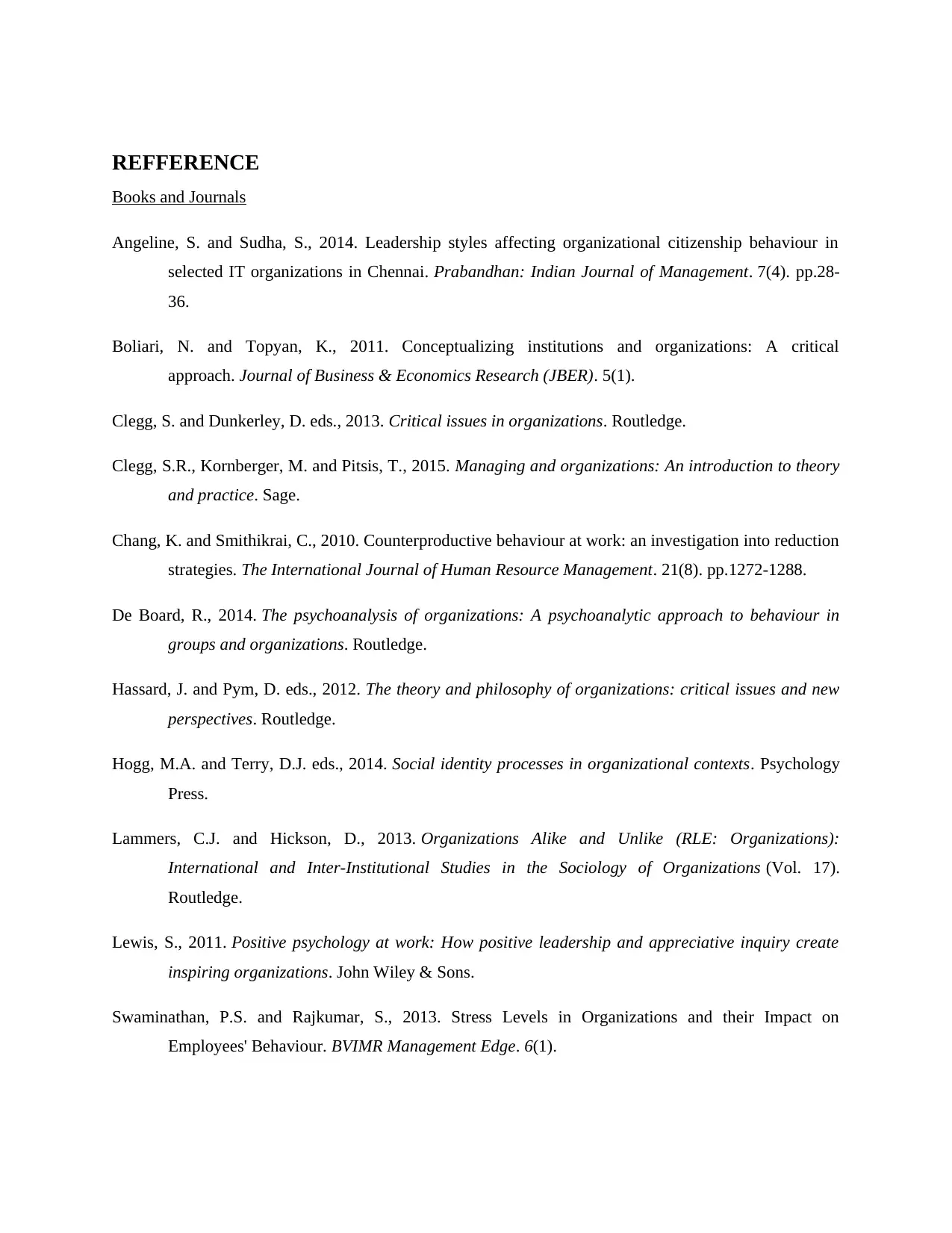
REFFERENCE
Books and Journals
Angeline, S. and Sudha, S., 2014. Leadership styles affecting organizational citizenship behaviour in
selected IT organizations in Chennai. Prabandhan: Indian Journal of Management. 7(4). pp.28-
36.
Boliari, N. and Topyan, K., 2011. Conceptualizing institutions and organizations: A critical
approach. Journal of Business & Economics Research (JBER). 5(1).
Clegg, S. and Dunkerley, D. eds., 2013. Critical issues in organizations. Routledge.
Clegg, S.R., Kornberger, M. and Pitsis, T., 2015. Managing and organizations: An introduction to theory
and practice. Sage.
Chang, K. and Smithikrai, C., 2010. Counterproductive behaviour at work: an investigation into reduction
strategies. The International Journal of Human Resource Management. 21(8). pp.1272-1288.
De Board, R., 2014. The psychoanalysis of organizations: A psychoanalytic approach to behaviour in
groups and organizations. Routledge.
Hassard, J. and Pym, D. eds., 2012. The theory and philosophy of organizations: critical issues and new
perspectives. Routledge.
Hogg, M.A. and Terry, D.J. eds., 2014. Social identity processes in organizational contexts. Psychology
Press.
Lammers, C.J. and Hickson, D., 2013. Organizations Alike and Unlike (RLE: Organizations):
International and Inter-Institutional Studies in the Sociology of Organizations (Vol. 17).
Routledge.
Lewis, S., 2011. Positive psychology at work: How positive leadership and appreciative inquiry create
inspiring organizations. John Wiley & Sons.
Swaminathan, P.S. and Rajkumar, S., 2013. Stress Levels in Organizations and their Impact on
Employees' Behaviour. BVIMR Management Edge. 6(1).
Books and Journals
Angeline, S. and Sudha, S., 2014. Leadership styles affecting organizational citizenship behaviour in
selected IT organizations in Chennai. Prabandhan: Indian Journal of Management. 7(4). pp.28-
36.
Boliari, N. and Topyan, K., 2011. Conceptualizing institutions and organizations: A critical
approach. Journal of Business & Economics Research (JBER). 5(1).
Clegg, S. and Dunkerley, D. eds., 2013. Critical issues in organizations. Routledge.
Clegg, S.R., Kornberger, M. and Pitsis, T., 2015. Managing and organizations: An introduction to theory
and practice. Sage.
Chang, K. and Smithikrai, C., 2010. Counterproductive behaviour at work: an investigation into reduction
strategies. The International Journal of Human Resource Management. 21(8). pp.1272-1288.
De Board, R., 2014. The psychoanalysis of organizations: A psychoanalytic approach to behaviour in
groups and organizations. Routledge.
Hassard, J. and Pym, D. eds., 2012. The theory and philosophy of organizations: critical issues and new
perspectives. Routledge.
Hogg, M.A. and Terry, D.J. eds., 2014. Social identity processes in organizational contexts. Psychology
Press.
Lammers, C.J. and Hickson, D., 2013. Organizations Alike and Unlike (RLE: Organizations):
International and Inter-Institutional Studies in the Sociology of Organizations (Vol. 17).
Routledge.
Lewis, S., 2011. Positive psychology at work: How positive leadership and appreciative inquiry create
inspiring organizations. John Wiley & Sons.
Swaminathan, P.S. and Rajkumar, S., 2013. Stress Levels in Organizations and their Impact on
Employees' Behaviour. BVIMR Management Edge. 6(1).
⊘ This is a preview!⊘
Do you want full access?
Subscribe today to unlock all pages.

Trusted by 1+ million students worldwide
1 out of 13
Related Documents
Your All-in-One AI-Powered Toolkit for Academic Success.
+13062052269
info@desklib.com
Available 24*7 on WhatsApp / Email
![[object Object]](/_next/static/media/star-bottom.7253800d.svg)
Unlock your academic potential
Copyright © 2020–2025 A2Z Services. All Rights Reserved. Developed and managed by ZUCOL.





